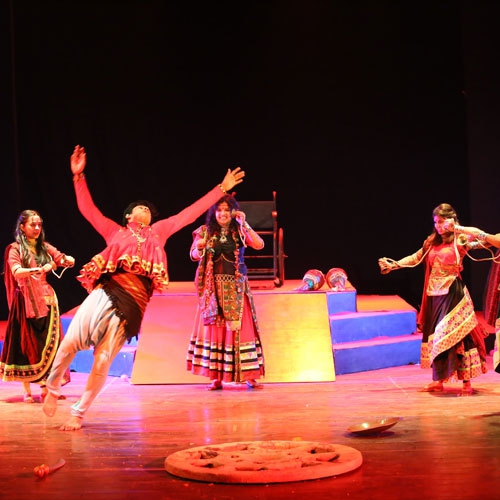
Event Info
- Language: Gujarati
- City / State: New Delhi
- Directed By: Dr. Chavan Pramod R.
- Produced By: Rang Prayog
Andha Yug (Gujarati Adaptation)
A retelling of the Mahabharata, and a Gujarati adaptation of the Hindi Andha Yug, this play opens with Dhrutarashtra and Gandhari grieving their dying sons against the backdrop of the Kurukshetra war and eagerly waiting for Sanjay, who, with his supernatural powers, can tell them the plight of their sons. The tension builds with Sanjay being lost at a later scene and Ashwatthama transformed into a destructive being to avenge his father’s death. Ashwatthama tries to kill Sanjay and releases the Brahmastra. The finale is the chilling reality of Gandhari being led to Duryodhan’s corpse and a dramatic cut to the modern "andha yug" we are living through.
CAST
Mallika Lokhande: Gandhari – 1
Aishwarya Sharma: Gandhari – 2
Avani Kansara: Gandhari – 3
Riya Doshi: Gandhari – 4
Vaidesha Lobiyal: Gandhari – 5
Ranganath Gopalarathnam: Dhrutarashtra
Bhavesh Thakarel: Ashwathama
Priyank Gangwani: Yuyutsu
Simant Rana: Sanjay
Prashanjit Dey: Vruddha Yachak
Mohammad Nawaz Khan: Vidura
Akhil Nair: Krutvarma / Western Dance
Shashank Jha: Krupacharya
Nirav Popat: Prahari – 1
Himadri Vyas: Prahari – 2 / Fashion Show
Ivan MD Khan: Vyasa / Fashion Show
Parth Nair: Chorus – 1 / Western Dance / Fashion Show
Hardik Soni: Chorus – 2
Tushar Vaishnav: Western Dance
CREW
Rishikesh Karanjgaokar: Lights
Sanket Chouhan: Music
Gaurav Chaturvedi: Makeup / Subtitles
Dr. Chavan Pramod R.: Performance Text, Design, Direction and Choreography
Inspired by Bharati's Andha Yug, this piece of work focuses solely on the 'thematic content of the play'. Rather than abiding by a ‘conventional structure’, it attempts to look 'beyond the barriers of time and space'.
The performance has been crafted with 'Gujarati folk culture' to express the entanglement of the characters with their situations, without distorting the original idea. Hence, pertaining to content, the performance emerges more subtly, symbolically and suggestively into a stylised form. The play raises questions about human tolerance of the atrocities of the war where women, children and youth play major victims. When will the world be peaceful? – this is the ultimate question. I have attempted to depict my perceptions about how various systems drive a region and its inhabitants into a fog of insoluble problems which reflect a restless society along with political turmoil, in which the sole sufferers are common people.